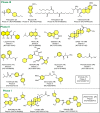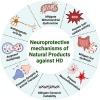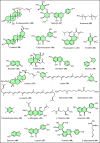The Emerging Landscape of Natural Small-molecule Therapeutics for Huntington's Disease
- PMID: 36797612
- PMCID: PMC10227909
- DOI: 10.2174/1570159X21666230216104621
The Emerging Landscape of Natural Small-molecule Therapeutics for Huntington's Disease
Abstract
Huntington's disease (HD) is a rare and fatal neurodegenerative disorder with no diseasemodifying therapeutics. HD is characterized by extensive neuronal loss and is caused by the inherited expansion of the huntingtin (HTT) gene that encodes a toxic mutant HTT (mHTT) protein having expanded polyglutamine (polyQ) residues. Current HD therapeutics only offer symptomatic relief. In fact, Food and Drug Administration (FDA) approved two synthetic small-molecule VMAT2 inhibitors, tetrabenazine (1) and deutetrabenazine (2), for managing HD chorea and various other diseases in clinical trials. Therefore, the landscape of drug discovery programs for HD is evolving to discover disease- modifying HD therapeutics. Likewise, numerous natural products are being evaluated at different stages of clinical development and have shown the potential to ameliorate HD pathology. The inherent anti-inflammatory and antioxidant properties of natural products mitigate the mHTT-induced oxidative stress and neuroinflammation, improve mitochondrial functions, and augment the anti-apoptotic and pro-autophagic mechanisms for increased survival of neurons in HD. In this review, we have discussed HD pathogenesis and summarized the anti-HD clinical and pre-clinical natural products, focusing on their therapeutic effects and neuroprotective mechanism/s.
Keywords: Huntington’s disease; Natural products; drug discovery; huntingtin (HTT); molecules; neuroprotective mechanisms; therapeutic interventions.
Copyright© Bentham Science Publishers; For any queries, please email at epub@benthamscience.net.
Conflict of interest statement
The authors declare no conflict of interest, financial or otherwise.
Figures









Similar articles
-
Protective Effects of Antioxidants in Huntington's Disease: an Extensive Review.Neurotox Res. 2019 Apr;35(3):739-774. doi: 10.1007/s12640-018-9989-9. Epub 2019 Jan 11. Neurotox Res. 2019. PMID: 30632085 Review.
-
The Huntington's disease drug pipeline: a review of small molecules and their therapeutic targets.Prog Mol Biol Transl Sci. 2025;211:169-207. doi: 10.1016/bs.pmbts.2024.08.006. Epub 2024 Oct 16. Prog Mol Biol Transl Sci. 2025. PMID: 39947748 Review.
-
A selective inhibitor of the NLRP3 inflammasome as a potential therapeutic approach for neuroprotection in a transgenic mouse model of Huntington's disease.J Neuroinflammation. 2022 Feb 26;19(1):56. doi: 10.1186/s12974-022-02419-9. J Neuroinflammation. 2022. PMID: 35219323 Free PMC article.
-
Huntington's Disease and Mitochondria.Neurotox Res. 2017 Oct;32(3):518-529. doi: 10.1007/s12640-017-9766-1. Epub 2017 Jun 21. Neurotox Res. 2017. PMID: 28639241 Review.
-
Neuroprotective Effects of σ2R/TMEM97 Receptor Modulators in the Neuronal Model of Huntington's Disease.ACS Chem Neurosci. 2022 Oct 5;13(19):2852-2862. doi: 10.1021/acschemneuro.2c00274. Epub 2022 Sep 15. ACS Chem Neurosci. 2022. PMID: 36108101 Free PMC article.
Cited by
-
Pathomechanisms of behavioral abnormalities in Huntington disease: an update.J Neural Transm (Vienna). 2024 Sep;131(9):999-1012. doi: 10.1007/s00702-024-02794-y. Epub 2024 Jun 14. J Neural Transm (Vienna). 2024. PMID: 38874766 Review.
-
Cannabinoids: Potential for Modulation and Enhancement When Combined with Vitamin B12 in Case of Neurodegenerative Disorders.Pharmaceuticals (Basel). 2024 Jun 20;17(6):813. doi: 10.3390/ph17060813. Pharmaceuticals (Basel). 2024. PMID: 38931480 Free PMC article. Review.
-
Berberine can be a Potential Therapeutic Agent in Treatment of Huntington's Disease: A Proposed Mechanistic Insight.Mol Neurobiol. 2025 May 16. doi: 10.1007/s12035-025-05054-6. Online ahead of print. Mol Neurobiol. 2025. PMID: 40377895 Review.
References
Publication types
MeSH terms
Substances
LinkOut - more resources
Full Text Sources
Medical

